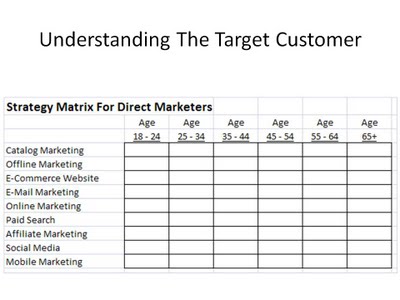This Week In Business: The Target Customer
 Caught between the social media snake oil ("Dell sold $3 million on Twitter, see, it works!") and the current state of affairs ("we have a Twitter presence and we've only been able to encourage 197 customers to follow us") is reality.
Caught between the social media snake oil ("Dell sold $3 million on Twitter, see, it works!") and the current state of affairs ("we have a Twitter presence and we've only been able to encourage 197 customers to follow us") is reality.The reality is that we don't have a good understanding of our "target customer".
No amount of data can supplement a vision for who the target customer is. And once you have a vision for who your target customer is, marketing becomes a lot easier.
Let's say that your target customer is a 57 year old woman. Do you honestly believe that you will have a robust mobile marketing program? Do you honestly think that you'll get 394,000 fifty-seven year old women to follow your sales messages on Twitter?
Let's say that your target customer is a 27 year old woman. Do you really think this customer wants to receive 27 catalogs in the mail every year?
A thorough understanding of the target customer goes a long way toward executing a successful marketing program.
For instance, we hear a lot these days about e-mail marketing falling by the wayside, being consumed by social media. Well, if your target customer is 45-54 years old, this may not be true. If your target customer is 25-34 years old, this may be 100% true. In either situation, the CMO ignores the screaming voices of the punditocracy, implementing marketing programs that are appropriate to the target customer.
The e-mail marketing community, folks now defending their niche from the onslaught of the social media elite, used to be critical of catalog marketers. Many marketing experts proclaimed that catalog marketing has been dead for a decade. And yet, if your target customer is 55-64 years old, there's still no single better vehicle to encourage a purchase than a catalog. Catalog marketing is alive and well to a certain target customer. Catalog marketing is dead when viewed across the entire demographic spectrum. Catalog marketing is also dead among the 55-64 year old segment hoping to improve the health of the planet.
As you can see, knowing your target market means everything to marketing success. This isn't a revolutionary idea.
We've been punched in the skull a few too many times, when it comes to thinking about marketing strategy. The social media folks, who run in circles who love social media, think social media solves every problem. Print marketing folks will always be able to find a metric that suggests that print marketing matters (67% of people age 18-69 say reading the mail is easier than reading a computer monitor). Banner advertisers know that 8% of the population click on almost all of the ads. E-mail marketers know that one in five subscribers are responsible for the majority of clicks. Based on localized metrics, we generalize, suggesting that everybody can be responsive to our marketing genre.
Heck, the whole "multichannel" movement has largely failed because we made the assumption that every good customer wants to interact with us across multiple channels.
There's never been a more important time to thoroughly know our target customer. We can use this knowledge to determine which marketing strategies are appropriate for customers in different life stages. Increasingly, my projects suggest that each customer has a channel preference, has a channel she is leaving, and a channel that she may be heading toward. We confuse this migration for being a rallying cry for "more of everything". Let's learn as much as we can about the target customer, and then offer the customer a better experience.
0 Comments:
Post a Comment
Links to this post:
Create a Link
<< Home